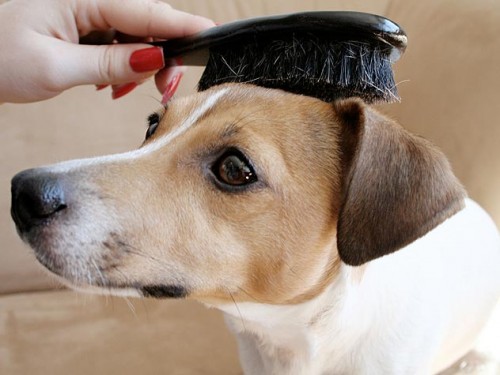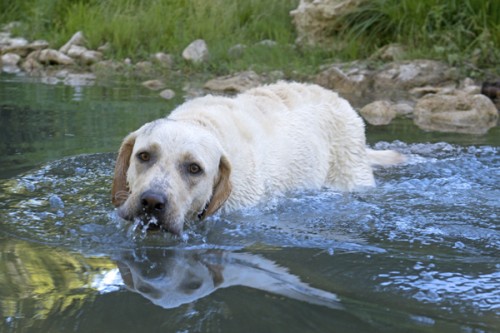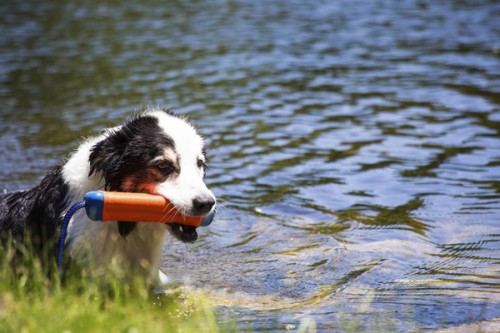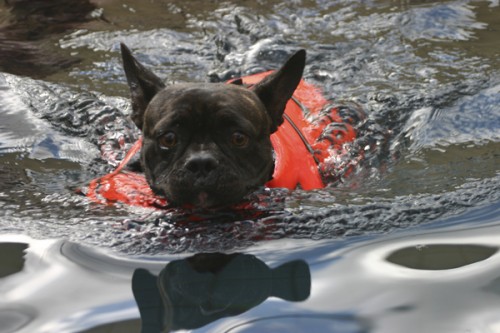How To Bathe a Dog: More Tips
Even though a good bath is one of the kindest things you can give your shelter’s dogs, chances are they’re not going to see it that way. But while you probably won’t win the hearts of all canines by getting them wet, you can make the experience more pleasant for both you and the dogs if you follow these steps. These instructions are appropriate for friendly shelter dogs in need of just a bit of cleaning. Heavily matted or aggressive dogs should be handled by a professional groomer.
1. Put on Your Wet Suit

2. Prepare the Pooch
Before starting the bath, you may want to let the dog get accustomed to you, and give her a chance to relieve herself. If the animal is particularly nervous, consider muzzling her and asking a partner to help you. Try to comb out major snarls in the dog’s fur, and trim her nails to keep her from clawing you accidentally. Put a drop of mineral oil in each of the dog’s eyes and cotton balls in her ears to keep water and soap from getting in them. Be sure to remove the cotton balls after the bath!
3. Lather, Rinse, Repeat
If the dog is heavy, don a back brace. Then lift the dog into the tub. Use a lightweight spray hose that can be maneuvered with one hand. Test the water temperature before spraying the dog, then gently get the dog used to the temperature by spraying water on her back and shoulders. After the dog relaxes, begin washing her head and then move gradually toward her rear; this will prevent fleas from moving up her body and congregating on her head and face. Lather the animal with a mild shampoo formulated for dogs. The active ingredient should be chlorhexidine, which is mildly antiseptic. If you must use an insecticide, use a gentle pyrethrin-based shampoo, and be sure to follow the safety instructions on the bottle. Oatmeal shampoos are good for dogs with itchy skin.
4. Make Fluffy Fluffy
Scrub and rinse the dog thoroughly. Soap stays in the fur long after it seems to be gone, so keep rinsing. When you finish, rub the dog down thoroughly with towels. Don’t put a wet dog back in her cageit’s okay if she’s just damp, especially if you have a climate-controlled facility. If you use an automated dryer that hangs on the front of the cage, test the temperature of the air before aiming it toward the dog, and check on the animal at least every 15 minutes or so to make sure she’s comfortable.
5. Suds Up the Puppies
Puppies have special bathing needs. Don’t use an insecticidal shampoo on a puppy unless the shampoo is formulated specifically for puppies and the puppy actually has fleas. With a young dog, it’s especially important to use warm water and make his bathing experience pleasant, using just the right combination of gentleness and firmness. If you are kind and sensitive to their fears, puppies will begin to regard their baths with pleasure rather than dread, making life more pleasant for you, for the puppies, and eventually for their adoptive families.
Pup-tato Skins Recipe
Want to make any easy dog-treat that you and your dog can both enjoy? Try our easy recipe for Pup-tato Skins using only a couple of ingredients. Whether you are “tail”-gating, making Irish Nachos for St. Patrick’s Day or just looking for an easy treat to try, these dog-friendly spuds are sure to be a crowd-pleaser. As with any treat, feed in moderation, especially if it’s your first time feeding a particular snack.

Fingerling or small yellow or red potatoes
You can also use full size russet potatoes, but you will need to cut them into smaller pieces.
Make sure they are an appropriate size for your dog so that they do not pose as a choking hazard.
Olive oil to lightly coat potatoes
Shredded cheese (1 tsp per potato)

Lightly coat potatoes with olive oil
Place potatoes on a lined sheet pan
Bake at 450 until fork-tender; about 45 min depending on the size of your potatoes
When potatoes are cool, cut in half lengthwise
Scoop out some of the potato to create a small well in your potato
Place potatoes back onto the baking sheet and sprinkle cheese into the well you have created
Bake again at 450 for 7-8 minutes or until cheese has melted

Best Dog Breeds for Swimming
One day as I watched my daughter’s Australian Shepherd, Cooper, and Labrador-mixed-breed, Kane, paddling in a lake, I noticed a rather significant variance in swimming form and style.
Kane’s webbed paws and strong legs moved him gracefully on the top of the water, his tail a remarkably effective rudder. Cooper, on the other hand, relied mainly on athleticism and determination. His paddling was powerful; his style was sub-par. But ever the herding dog, Cooper happily followed Kane back and forth in the water. As he grew tired, his “never give up” solution was to try to hitch a ride on Kane’s back. Thankfully Kane is as strong as an ox, and ridiculously tolerant about being his brother’s keeper, and/or his lifeboat.

8 Dog Breeds Born to Swim
1. Chesapeake Bay Retriever
Chessies were developed as vigorous water retrievers, strong enough to swim in the cold, rough Chesapeake Bay, and retrieve a hundred birds per day. The Chessie has webbed feet to assist his Olympic-level swimming. Good luck tiring him out in the water throwing a ball.
2. Labrador Retriever
Predecessors of the Labrador Retriever worked with Newfoundland fisherman off the Labrador Sea shores. Renowned for energy in the water and out, the breed was further developed in England for hunting and retrieving. The powerful Lab has webbing between his toes and a strong otter-like tail for swimming. Odds are he’ll match his swimming talent with dock diving, if given the chance.
3. Newfoundland
The Newfoundland was bred to brave freezing cold waters as he worked with fishermen. Fantastic water rescue tales abound about the valiant Newfoundland. With his raw strength, webbed feet, and water resistant coat, the Newfoundland today can’t wait for the opportunity to take to the water. Hopefully his owner likes liquid of all sorts, given the Newfie’s famous drooling and slobbery kisses.
4. Portuguese Water Dog
Bred to accompany fisherman, Portuguese Water Dogs can dive as well as swim. Historically developed to dive for fish and retrieve nets, Portuguese Water Dogs also delivered messages between boats and guarded boats in port. Families today will find their Portuguese Water Dogs head straight into water when the opportunity presents. Getting the dog to come back to land may be more challenging.
5. Brittany
Developed to both point and retrieve, the Brittany became a popular gun dog in the early 20th century. His breed history lacks the swimming legacy of the water-retrievers, but he’s game for activity on both land and water. The Brittany has limitless energy, a wash-and-go coat, and — weighing in at about 30 pounds — he’ll hardly mess up your car after a swimming day.
6. Poodle
The Poodle breed name probably originates from the German Pudel, meaning “one who plays in water.” The famous Poodle clip in actuality was designed not for glamor, but to facilitate swimming. A Toy Poodle can swim too, but smaller dogs may tire over long distances.
7. Nova Scotia Duck Tolling Retriever
Bred to toll, lure, and retrieve waterfowl, water might as well be this breeds middle name. Hunters took note the behavior of wild foxes, who playfully lured waterfowl to the shore making them easy pray and trained these dogs to mimic the action. Believed to be related to the Chesapeake Bay Retriever and the Brittany it’s no surprise that this breed is such a graceful swimmer.
8. Australian Shepherd
Now it’s time to defend Cooper and Aussies everywhere. Bred as an all-around working dog, Aussies can swim. They don’t have webbed feet or a rudder-like tail (or much of a tail at all for that matter). Their swimming will certainly lack the finesse of other water breeds. After all, Aussies were bred to help ranchers and herd livestock. Nevertheless, the endlessly energetic Aussie will work and play anywhere, including in the water.

1. Bulldog
Dogs bred with heavy chests relative to their hindquarters aren’t designed for swimming. Given their body type, paddling to carry their weight can be daunting if not impossible. While many are known to surf and skateboard they are happier going along for the ride than rowing their own boat. Many enjoy sitting in a kiddie pool, but anything deeper than that, get them a raft and a life jacket.
2. French Bulldog
Like the Bulldog, Frenchies are not buoyant by nature. The Frenchie won’t likely care about his aquatic inadequacy; he was bred for companionship, not athletic adventures. Owners inclined to take a Frenchie near water should invest in a dog life jacket. More About French Bulldogs>>

Due their unique size and shape, Bassets more closely resemble an anchor than a swimming dog. Swimming can be a difficult feat for the Basset Hound. The breeds short legs, heavy front-end and drooping skin, makes it hard for them to keep their heads above the water. While they need a life jacket for anything deep, they will enjoy cooling off in shallow water. Sprinklers are probably a bit more their speed.
4. Pug
A breed with roots to antiquity, the Pug in the Toy Group was bred for friendship, not to work for a living. A few Pugs may enjoy a casual dip in the water, but the breed’s short snout contributes to his lack of stamina. Owners must supervise closely and fit the lif ejacket on the Pug…snug.





